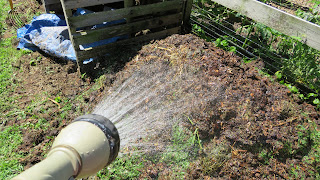 |
| The Basic Compost Pile - Just Get Started |
The composting of mixed organic matter, tossed in a bin or pile, can take several years to fully breakdown. This method is known as cold composting. Hot composting is mixing ratios of greens/nitrogen and browns/carbon so that the pile heats up to over 120 F. and this accelerates the decomposition process, creating viable compost in as little as 60 days. The latter takes weekly tending and care to maintain the heating of the pile.
Cold composting is a long wait, hot composting requires more time. There is a middle grown that is not much more than layering your carbons such as old dried organic garden debris, hay, or even shredded cardboard with fresh cut untreated grass. No special exact measurements are needed. Just rotate layers, soak with a hose, and cover with a tarp. Let Nature do the work.
 |
| At My Shop: Limited Edition Shirts |
I compost in many ways and have been using this method for that last 5 years. I use it to finish off the composting process of older dry materials. Under the blue tarp is a new pile and the wagon and wheelbarrow are filled with compost from the remains of the previous pile. It works. You just have to get started.
 |
| Layer of Brown/Carbon or Dried Material |
I am just putting down dried organic matter from other bins. You could use hay or even shredded cardboard. If you let a compost pile dry out, the material breakdown slows down greatly. Microbes need moisture to decay the material. The above is a layer of browns, 1/2 inch to 3 inches or so in different places across the pile. Just a layer and let it fall where it falls.
 |
| Layer of Green/Nitrogen of Fresh Material |
Next is a layer of freshly cut untreated grass. Again, just layered across the previous layer of brown material. Continue this until the pile gets about 3-4 feet tall. Just keep the layers going and build the pile. The pile is being built with lots of 'fluffiness' meaning good air/oxygen flows through the material. Oxygen helps accelerate good microbes reproduction and digestion of the organic matter. I do not turn this pile and typically build it by August 1st. I use it 90-120 days later to put my garden beds to sleep in the late fall and I use it again to wake them up in the spring.
 |
| Completed Height of a Layered Compost Pile |
I like to finish it with browns on top of the pile. The grass, because of the high nitrogen content, heats up and helps speed up the breakdown. Not as hot when you are hot composting, but it aids in the speed of the decay of the pile. It doesn't need to be 100% decomposed come fall as you are applying this to the top of the beds. It will continue to decompose on the beds. The final steps are to fully and that means soak the pile and cover it with a tarp. Excess water will drain away. I like using the tarp as it creates a dark space, keep the pile warmer, and I feel speeds up the process. It is possible for mice, moles, and voles to take up living under a tarp. I recommend disturbing and lifting the tarp a couple times a month and letting the sun get in. If it seems dry, you can add water.
 |
| Moisture Maintains Microbes |
Tossing materials into a pen for cold composting or starting a pile like this are two of the easiest ways to get started. If you start with a pen, you'll have plenty of browns next year, for the above layering process. The barrier really is getting started with some sort of compost pile. Follow my blog as I will be doing updates on this pile and showing how I use compost in my fall and spring beds. My video covers the process and shows the pile I just made for 2023.
Subscribe to my
YouTube Channel The Rusted Garden Homestead
Over 650,000 Subscribers and Over 2000 Garden
Videos Designed to Quickly Present Information!
Visit The Rusted Garden Seed and Garden Shop
for your Seeds, Starting Supplies, Fabric Pots, Neem Oil,
Peppermint and Other Oils, Calcium Nitrate and More.
The Rusted Garden Seed and Garden Shop

No comments:
Post a Comment
Visit The Rusted Garden's YouTube Video Channel
Follow The Rusted Garden on Pinterest